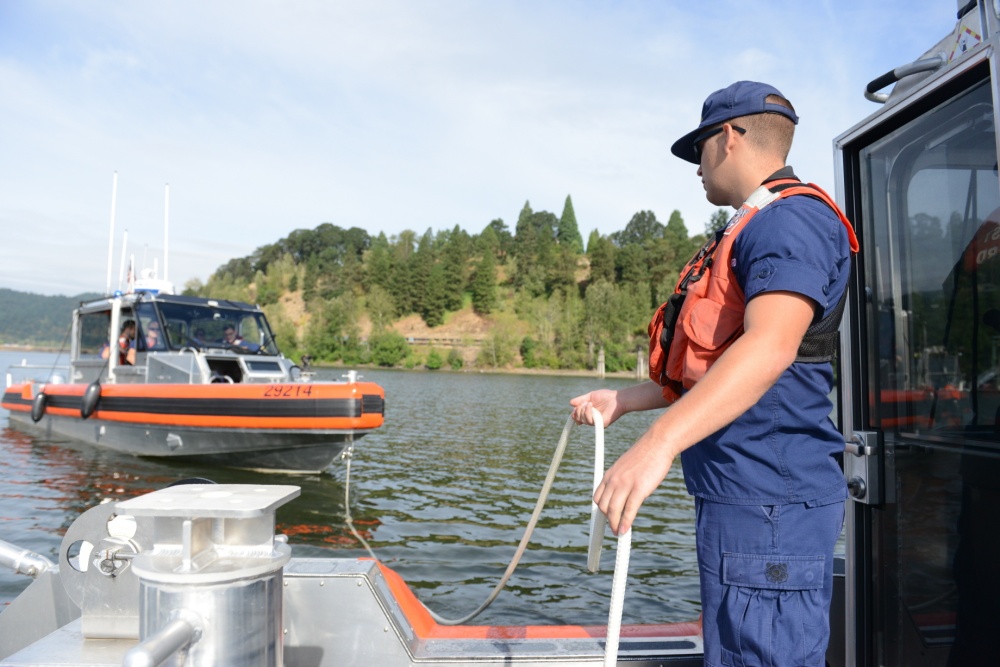Good news for reservists! One of the first items to be implemented by the Reserve End Strength Regeneration Action Team (RESAT) is kicking off in October with the Flexible Personnel Allowance List (FlexPAL). RESAT was established to restore the Selected Reserve (SELRES) to its authorized strength of 7,000 members.
The main goal of FlexPAL is to provide geographic stability and flexibility for our workforce by reducing the number of reservists who have to travel outside of the reasonable commuting distance (RCD) to drill.
 |
| Petty Officer 3rd Class Lowell Belany, a reserve boatswain's mate out of Coast Guard Station Vallejo, Calif., takes the helm while navigating waypoints along the Columbia River during the Reserve Coxswain College in Portland, Ore., Aug 28, 2015. Students attending the college were required to plot out and navigate to waypoints using different on land reference points along the Columbia River. (U.S. Coast Guard photo by Petty Officer 3rd Class Jonathan Klingenberg) |
FlexPAL identifies units that have training capacity, allowing vacant reserve billets throughout the Coast Guard to be moved to these units. This allows more assignment flexibility, assists with recruiting efforts, and reduces travel-related expenses for members and the Coast Guard.
Each unit’s training capacity will be evaluated to ensure SELRES members can achieve training objectives and mission requirements without jeopardizing the quality of training. The number of reservists that can be trained at a unit is not the same as the number of reserve positions that exist at the unit’s PAL.
We have many instances of double- triple-, and even quadruple-encumbered positions. Many units will have the ability to train reservists in excess of their current RPAL.
“Right now, more than 60 percent of our reservists have to travel to drill, so reducing the burden on our members was a huge goal for us,” said Capt. Jennifer Travers with the Office of Reserve Resources, Readiness, and Analysis. “We want to make it easier to serve."
The first step of implementing FlexPAL is already underway. Positions designated as long-term vacancies per current policy will be redistributed to greatly reduce the number of multi-encumbered positions that exist today by providing each E4 to E6 reservist with their own unique position.
Many units that have SELRES members assigned will see an ebb and flow of E4 to E6 billets. Units with unfilled training capacity may see an increase in assigned members, while other units with high vacancy rates will see a reduction in positions attached to the unit.
“If a unit has the capacity to train 20 members during the month, they will have the flexibility to offer that training to our reserve forces,” said Travers. “This helps our force remain geographically stable, and it allows junior personnel to serve at the same unit through career advancement—one that is close to their home.”
There are some exceptions to FlexPAL: understandably, certain units (PSUs and COCOMs) and individual leadership positions (like senior enlisted reserve advisors, gold and silver badges, and senior reserve officers) will not be flexible.
 |
| Coast Guard reservists practice towing evolutions during the Reserve Coxswain College course held in Portland, Ore., Sept. 1, 2015. While at the college, the students learned different towing methods, chart plotting, navigation, emergency casualty control as well as several different boat handling skills. (U.S. Coast Guard photo by Petty Officer 3rd Class Jonathan Klingenberg) |
The final step in the FlexPAL implementation will be the use of the system for all applicable assignments (e.g. advancements, accessions, etc). CG-R is taking a look at policy to find ways to better support a geographically stable workforce and the FlexPAL provides a number of options towards that goal that did not exist previously.
For questions or comments concerning this process and initiative, contact Lt. Chris Mohnke at christopher.r.mohnke@uscg.mil or view FlexPAL documents on the CG-R portal at https://cg.portal.uscg.mil/units/CG-R/FlexPAL/Forms/AllItems.aspx.The Coast Guard is implementing an opportunity for reservists to drill closer to home in an effort to grow the reserve component to 7,000 members.